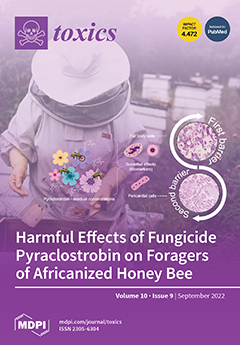Recently, many approaches have been developed to improve the performance of nanomaterials. Combining more than one nanomaterial is one such approach that achieves superior results. However, during the fabrication of nanomaterials or formulation of end products, materials can be released into the ambient
[...] Read more.
Recently, many approaches have been developed to improve the performance of nanomaterials. Combining more than one nanomaterial is one such approach that achieves superior results. However, during the fabrication of nanomaterials or formulation of end products, materials can be released into the ambient air and be inhaled by workers. The adverse health outcomes of inhaling such compounds are unknown. In this study, we examined such effects in combining two of the most utilized nanomaterials in several industrial sectors: zinc oxide (ZnO) and cerium oxide (CeO
2). These materials can be found together in sunscreens, polyvinyl alcohol (PVA) films, and construction products. The aim of this study was to assess the adverse biological outcomes of CeO
2–ZnO nano-mixtures in human lung epithelial cells. A549 human lung epithelial cells were treated with increasing concentrations of ZnO or CeO
2 NPs alone, or as a mixture of both, under submerged conditions for 24 h. After treatment, cell viability, reactive oxygen species (ROS) formation, cell membrane integrity, and cytokine production were examined. ZnO NPs showed a dose-dependent trend for all endpoints. CeO
2 NPs did not exhibit any toxic effect in any individual concentrations. When higher doses of ZnO were combined with increasing doses of CeO
2, loss of cell viability and an elevation in cell membrane leakage were observed. Interleukin 8 (IL-8) and ROS generation were higher when ZnO NPs were combined with CeO
2 NPs, compared to cells that were treated with ZnO alone. The release of monocyte chemoattractant protein-1 (MCP-1) was reduced in the cells that were treated with higher doses of ZnO and CeO
2. Thus, the presence of CeO
2 enhanced the toxicity of ZnO in A549 cells at non-toxic levels of CeO
2. This suggests an additive toxicity of these two nanomaterials.
Full article






